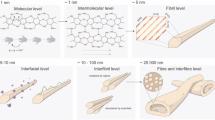Abstract
A new dissolution method, a two-step process, for cellulose in NaOH/urea aqueous system was investigated with 13C NMR, wide X-ray diffraction (WXRD), and solubility test. The two steps were as follows: (1) formation and swelling of a cellulose–NaOH complex and (2) dissolution of the cellulose–NaOH complex in aqueous urea solution. The dissolution mechanism could be described as strong interaction between cellulose and NaOH occurring in the aqueous system to disrupt the chain packing of original cellulose through the formation of new hydrogen bonds between cellulose and NaOH hydrates, and surrounding the cellulose–NaOH complex with urea hydrates to reduce the aggregation of the cellulose molecules. This leads to the improvement in solubility of the polymer and stability of the cellulose solutions. By using this two-step process, cellulose can be dissolved at 0–5 °C in contrast to the known process that requires −12 °C. Regenerated cellulose (RC) films with good mechanical properties and excellent optical transmittance were prepared successfully from the cellulose solution.








Similar content being viewed by others
References
Brown W, Wikstrom R (1965) A viscosity-molecular weight relationship for cellulose in cadoxen and a hydrodynamic interpretation. Eur Polym J 1:1–10
Cai J, Zhang L (2005) Rapid dissolution of cellulose in LiOH/urea and NaOH/urea aqueous solutions. Macromol Biosci 5:539–548
Cai J, Zhang L, Liu S, Liu Y, Xu X, Chen X, Chu B, Guo X, Xu J, Cheng H, Han CC, Kuga S (2008) Dynamic self-assembly induced rapid dissolution of cellulose at low temperature. Macromolecules 41:9345–9351
Egal M, Budtova T, Navard P (2007) Structure of aqueous solutions of microcrystalline cellulose/sodium hydroxide below 0 °C and the limit of cellulose dissolution. Biomacromolecules 8:2282–2287
Egal M, Budtova T, Navard P (2008) The dissolution of microcrystalline cellulose in sodium hydroxide-urea aqueous solutions. Cellulose 15:361–370
Fink HP, Weigel P, Purz HJ, Ganster J (2001) Structure formation of regenerated cellulose materials from NMMO-solutions. Prog Polym Sci 26:1473–1524
Heinze Th, Dicke R, Koschella A, Kull AH, Klohr EA, Koch W (2000) Effective preparation of cellulose derivatives in a new simple cellulose solvent. Macromol Chem Phys 201:627–631
Isogai A, Atalla RH (1998) Dissolution of cellulose in aqueous solutions. Cellulose 5:309–319
Kamide K, Okajima K, Matsui T, Kowsaka K (1984) Study on the solubility of cellulose in aqueous alkali solution by deuteration IR and 13C NMR. Polymer 16:857–866
Kamide K, Okajima K, Kowsaka K (1992) Dissolution of natural cellulose into aqueous alkali solution: role of super-molecular structure of cellulose. Polym J 24:71–86
Kaplan DL (1998) Biopolymers from renewable resources. Spinger, Berlin, p 55
Kuo YN, Hong J (2005) Investigation of solubility of microcrystalline cellulose in aqueous NaOH. Polym Adv Technol 16:425–428
McCormick CL, Callais PA, Hutchinson BH (1985) Solution studies of cellulose in lithium chloride and N, N-dimethylacetamide. Macromolecules 18:2394–2401
Nehls I, Wagenknecht W, Philipp B, Stscherbina D (1994) Characterization of cellulose and cellulose derivatives in solution by high resolution carbon-13 NMR spectrometry. Prog Polym Sci 19:29–78
Porro F, Bédué O, Chanzy H, Heux L (2007) Solid-state 13C NMR study of Na-cellulose complexes. Biomacromolecules 8:2586–2593
Qi H, Chang C, Zhang L (2008) Effects of temperature and molecular weight on dissolution of cellulose in NaOH/urea aqueous solution. Cellulose 15:779–787
Qi H, Chang C, Zhang L (2009) Properties and applications of biodegradable transparent and photoluminescent cellulose films prepared via a green process. Green Chem 11:177–184
Roy C, Budtova T, Navard P, Bedue O (2001) Structure of cellulose-soda solutions at low temperatures. Biomacromolecules 2:687–693
Ruan D, Zhang L, Zhou J, Jin H, Chen H (2004) Structure and properties of novel fibers spun from cellulose in NaOH/thiourea aqueous solution. Macromol Biosci 4:1105–1112
Schurz J (1999) ‘Trends in Polymer Science’ a bright future for cellulose. Prog Polym Sci 24:481–483
Sobue H, Kiessig H, Hess K (1939) The system: cellulose-sodium hydroxide-water in relation to the temperature. Z Phys Chem B43:309–328
Swatloski RP, Spear SK, Holbrey JD, Rogers RD (2002) Dissolution of cellulose with ionic liquids. J Am Chem Soc 124:4974–4975
Turner MB, Spear SK, Holbrey JD, Rogers RD (2004) Production of bioactive cellulose films reconstituted from ionic liquids. Biomacromolecules 5:1379–1384
Yamane C, Saito M, OkajimaK (1996) Manufacture of new cellulosic fibers from a spinning bath of an aqueous solution of alkali—soluble cellulose and caustic soda. Part 1. Development of a method for industrial preparation of an aqueous solution of highly soluble cellulose and caustic soda. Sen’i Gakkaishi
Yan L, Gao Z (2008) Dissolving of cellulose in PEG/NaOH aqueous solution. Cellulose 15:789–796
Zhang L, Ruan D, Gao S (2002) Dissolution and regeneration of cellulose in NaOH/thiourea aqueous solution. J Polym Sci B Polym Phys 40:1521–1529
Zhang H, Wu J, Zhang J, He J (2005) 1-Allyl-3-methylimidazolium chloride room temperature ionic liquid: a new and powerful nonderivatizing solvent for cellulose. Macromolecules 38:8272–8277
Zhou J, Zhang L (2000) The solubility of cellulose in NaOH/urea aqueous solution. Polym J 10:866–870
Acknowledgments
This work was supported by National Basic Research Program of China (973 Program, 2010CB732203), National Supporting Project for Science and Technology (2006BAF02A09), the National High Technology Research and Development Program of China (863 Program, 2003AA333040 and 2006AA02Z102), major grants of the National Natural Science Foundation of China (30530850 and 59933070), the National Natural Science Foundation of China (20474048 and 20874079), and the Federal Ministry of Economics and Technology (DECHEMA Gesellschaft für Chemische Technik and Biotechnologie e.V., project number AiF 15875 BR).
Author information
Authors and Affiliations
Corresponding authors
Rights and permissions
About this article
Cite this article
Qi, H., Yang, Q., Zhang, L. et al. The dissolution of cellulose in NaOH-based aqueous system by two-step process. Cellulose 18, 237–245 (2011). https://doi.org/10.1007/s10570-010-9477-8
Received:
Accepted:
Published:
Issue Date:
DOI: https://doi.org/10.1007/s10570-010-9477-8




